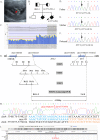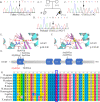Genetic analysis of 55 cases with fetal skeletal dysplasia
- PMID: 36352425
- PMCID: PMC9648031
- DOI: 10.1186/s13023-022-02559-4
Genetic analysis of 55 cases with fetal skeletal dysplasia
Abstract
Background: Fetal skeletal dysplasia (SD) is a common congenital disability comprising a complex group of skeletal disorders with substantial clinical and genetic heterogeneity. Many of these defects are detected prenatally using ultrasound (US). However, the diagnostic accuracy of the US is limited.
Methods: We recruited 55 unrelated fetuses with US-detected skeletal anomalies and performed sequential tests using copy number variation sequencing, targeted skeletal gene panel sequencing, or whole exome sequencing. The detected variants were validated using Sanger sequencing or multiplex ligation-dependent probe amplification. We conducted breakpoint analysis and structural modeling of variants possibly involved in fetal SD.
Results: A definitive diagnosis was achieved in 81.82% of affected fetuses (45/55). We identified chromosomal abnormalities in seven cases and 36 variants, of which 18 were novel pathogenic or likely pathogenic in 11 genes in 38 cases. De novo variants were identified in 27 cases (71.05%, 27/38), and one gonosomal mosaicism variant was found in the mother of one fetus. Our case examples demonstrated the high heterogeneity of fetal SDs and the rare fetal SD-associated challenges.
Conclusions: Careful clinical evaluation of fetuses with SD can guide appropriate molecular testing. Our study extends the SD-associated pathogenic variant spectrum and provides useful genetic counselling guidance and an accurate prenatal diagnosis strategy.
Keywords: Breakpoints; Genotype–phenotype analysis; Molecular diagnosis; Novel variants; Skeletal dysplasia.
© 2022. The Author(s).
Conflict of interest statement
The authors have declared no conflicting interests.
Figures





Similar articles
-
Prenatal exome sequencing analysis in fetal structural anomalies detected by ultrasonography (PAGE): a cohort study.Lancet. 2019 Feb 23;393(10173):747-757. doi: 10.1016/S0140-6736(18)31940-8. Epub 2019 Jan 31. Lancet. 2019. PMID: 30712880 Free PMC article.
-
Prenatal diagnosis of fetal skeletal anomalies via whole-exome sequencing in a tertiary referral center.Sci Rep. 2024 Nov 9;14(1):27371. doi: 10.1038/s41598-024-75738-x. Sci Rep. 2024. PMID: 39521787 Free PMC article.
-
Whole-exome sequencing in the evaluation of fetal structural anomalies: a prospective cohort study.Lancet. 2019 Feb 23;393(10173):758-767. doi: 10.1016/S0140-6736(18)32042-7. Epub 2019 Jan 31. Lancet. 2019. PMID: 30712878
-
Update on the use of exome sequencing in the diagnosis of fetal abnormalities.Eur J Med Genet. 2019 Aug;62(8):103663. doi: 10.1016/j.ejmg.2019.05.002. Epub 2019 May 11. Eur J Med Genet. 2019. PMID: 31085342 Review.
-
Evaluation of prenatally diagnosed structural congenital anomalies.J Obstet Gynaecol Can. 2009 Sep;31(9):875-881. doi: 10.1016/S1701-2163(16)34307-9. J Obstet Gynaecol Can. 2009. PMID: 19941713 Review. English, French.
Cited by
-
Exome sequencing and prenatal skeletal abnormalities: comprehensive review and meta-analysis and way forward.Front Genet. 2025 Jun 11;16:1502538. doi: 10.3389/fgene.2025.1502538. eCollection 2025. Front Genet. 2025. PMID: 40567897 Free PMC article.
-
Sequential prenatal diagnosis of fetal skeletal dysplasia: A cohort study.Acta Obstet Gynecol Scand. 2025 May;104(5):860-874. doi: 10.1111/aogs.15095. Epub 2025 Mar 4. Acta Obstet Gynecol Scand. 2025. PMID: 40035361 Free PMC article.
-
Antenatal unilateral upper limb acromesomelic dysplasia.J Ultrasound. 2024 Sep 17. doi: 10.1007/s40477-024-00954-0. Online ahead of print. J Ultrasound. 2024. PMID: 39287886
-
Identification of copy number variants contributing to hallux valgus.Front Genet. 2023 Mar 23;14:1116284. doi: 10.3389/fgene.2023.1116284. eCollection 2023. Front Genet. 2023. PMID: 37035746 Free PMC article.
References
Publication types
MeSH terms
LinkOut - more resources
Full Text Sources

